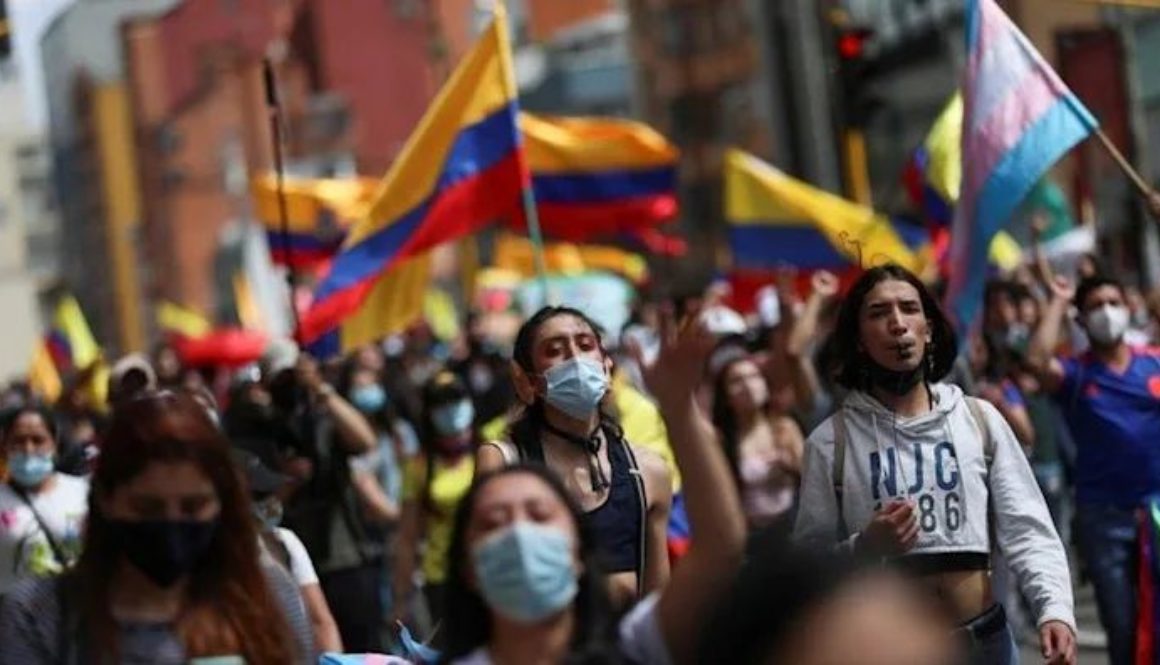Why Colombia’s protests are unlikely to fizzle out
Dozens of people have died since a wave of protests started to sweep across Colombia on 28 April.
Protesters have blocked key roads leading to shortages of fuel and food in some areas and there have been violent clashes between the security forces and demonstrators.
The government has agreed to meet protest leaders but with more and more groups joining in the protests, the demands of those who have taken to the streets have widened and a quick resolution seems unlikely.

BBC News takes a closer look at what triggered the protests and how they have grown.
How did they start?
The demonstrations started on 28 April and were initially in opposition to a proposed tax reform.
The government argued that the reform was key to mitigating Colombia’s economic crisis.
Colombia’s gross domestic product dropped by 6.8% last year, the deepest crash in half a century. Unemployment shot up as the coronavirus pandemic wreaked havoc on the economy.
The proposed reform would have lowered the threshold at which salaries are taxed, affecting anyone with a monthly income of 2.6m pesos ($684; £493) or more. It would also have eliminated many of the current exemptions enjoyed by individuals, as well as increasing taxes imposed on businesses.
The rallies on 28 April were organised by Colombia’s biggest trade unions, but were also joined by many middle-class people who feared the changes could see them slip into poverty.
Tens of thousands of people marched in the capital Bogotá but there were also demonstrations in other major cities and smaller towns.
After four days of protests, President Iván Duque announced he would withdraw the bill.
How did protests escalate?
From the start, there was a big police presence at the marches as they were held in defiance of a court order which had ruled that they should be postponed due to the high incidence of Covid-19.
Human rights groups reported that riot police had not only used tear gas to disperse protesters but in some cases shot live ammunition.
Footage shared on social media showed violent clashes and on 3 May, the ombudsman’s office confirmed that 16 civilians and one police officer had died since the protests began.
So rather than abating after the cancellation of the tax reform, the protests intensified.
In Bogotá, more than a dozen police stations were attacked and police said hundreds of their officers were among the 800 people injured in clashes.
What do protesters want?
While this year’s protests were triggered by the now-suspended tax reform, they are a continuation of nationwide anti-government protests which began in November 2019.
Back then, hundreds of thousands of people took to the streets after a call by an umbrella group calling itself the National Strike Committee.
The same group is behind the current protests and its demands are as varied as the people who are joining in the marches.
One of the issues which has most angered protesters is the actions of riot police.
On 4 May, the United Nation’s human rights office accused Colombia’s security forces of using excessive force and said it was “deeply alarmed” by reports that police had opened fire on protesters.
The protesters want the riot police to be disbanded and for all members of the security forces to be held accountable by an independent body rather than by military courts.
The defence minister said that the protests had been infiltrated by members of left-wing rebel groups and pointed to incidents of vandalism and looting.
But protesters argue it is time the security forces, which for decades were engaged in an armed conflict with powerful rebel groups, treated them like citizens rather than enemies.
What role does poverty play?
Many of the protesters’ demands are rooted in Colombia’s high levels of inequality. The coronavirus pandemic has made the lives of many Colombians more precarious, with unemployment spreading and 3.6m Colombians being pushed into poverty.
In cities like Quibdó, in the north, 30% of people live in extreme poverty and even in Medellín, Colombia’s economic powerhouse, that figure amounts to 9%, according to official sources.
Some of the protesters argue that only the introduction of a universal basic income will ease inequality while Colombia’s young are demanding that tuition fees be dropped so that more can access university education.
Indigenous groups have also joined in the protests. They are among those hardest hit by the continuing violence in rural areas where dissident members of the Farc rebel group fight the security forces as well as rival armed groups.
Twenty indigenous leaders are among 60 rights defenders killed since the beginning of the year, according to a tally by peace institute Indepaz, and Colombians are demanding that the state do more to protect those standing up for rural, indigenous and Afro-Colombian communities.
What does the government say?
President Duque has ruled out one of the protesters’ main demands – the dismantling of the riot police. Nevertheless he struck an optimistic note ahead of talks with the National Strike Committee but urged demonstrators to clear the roads they have blocked. “Yes to conversation … but no to roadblocks,” he said.
“Colombia has to pull together to move forward after all the blows we were dealt during the pandemic,” he said.
He also addressed young people in Valle del Cauca, the region where the violence has been at its worst, tweeting that “we know of your demands and proposals and there will be a space to hear you out and talk about the issues worrying you. Let’s together reach concrete solutions quickly”.


You must be logged in to post a comment.